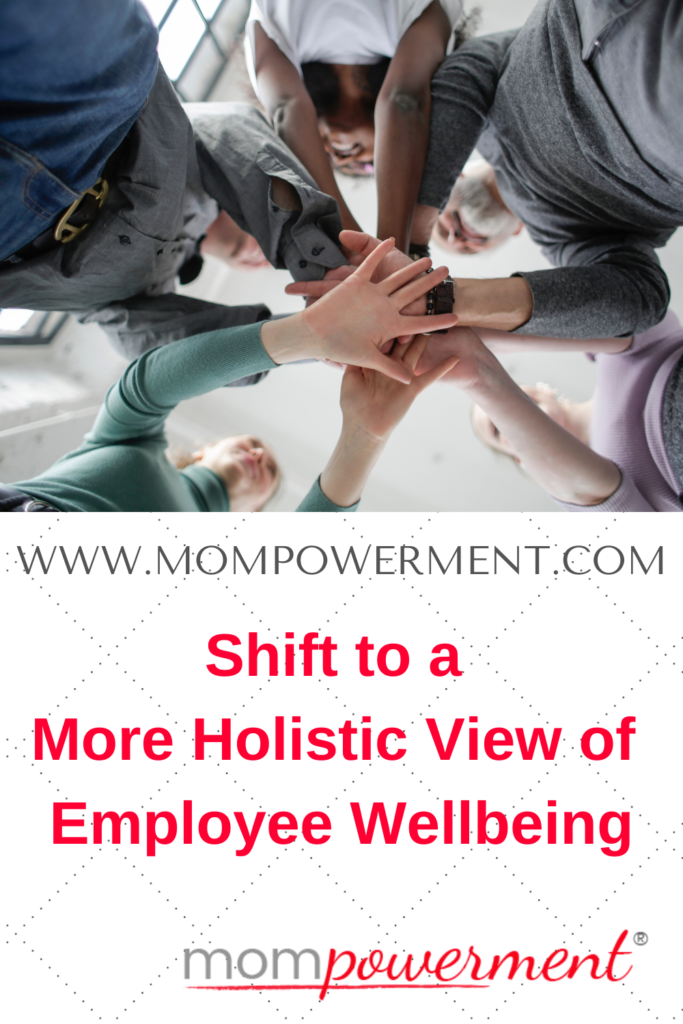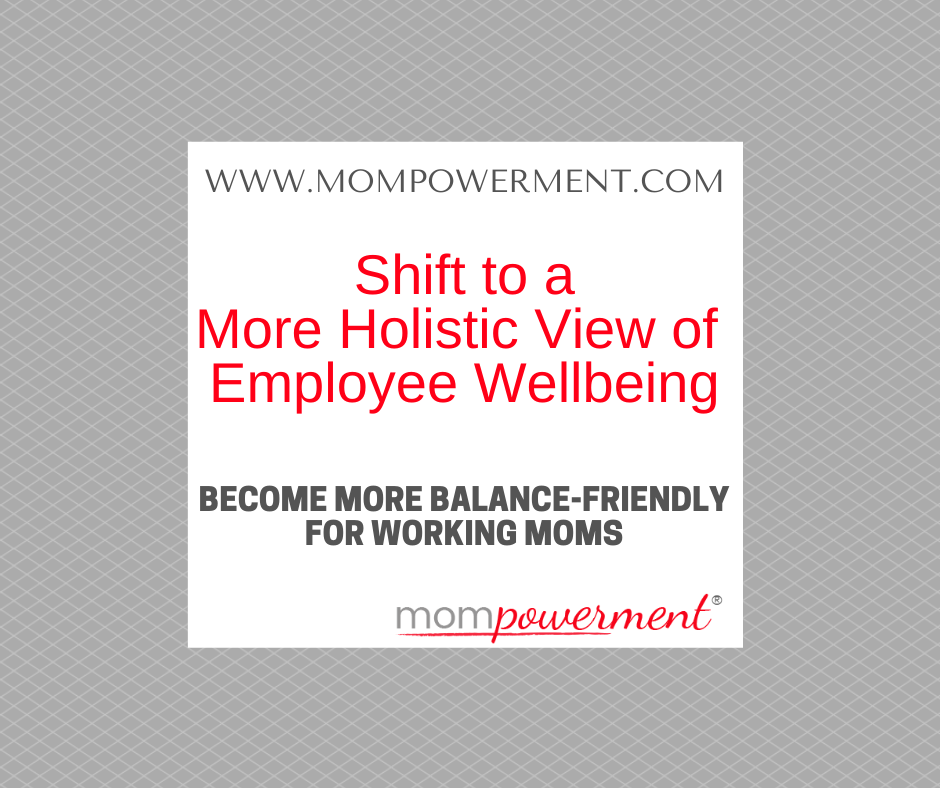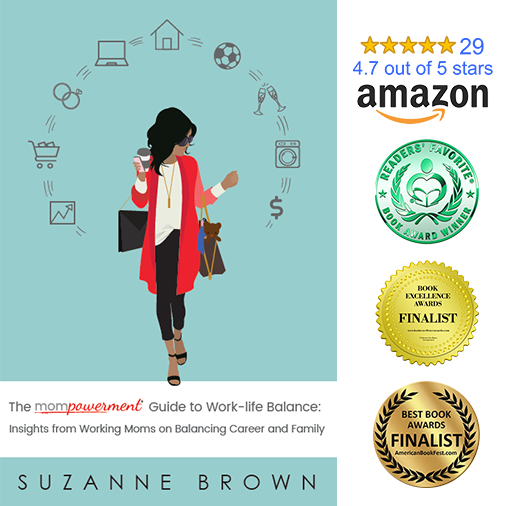
Employees’ needs have changed, especially during and as a result of the pandemic. Simply providing health insurance as your sole benefit is no longer enough. As the second post in this month-long series for employers, I share tips to help you start to shift to a more holistic view of employee wellbeing, especially for working moms and dads, to include physical, mental, emotional, social, and financial health.
What’s at stake if you don’t change?
If your approach to employee wellbeing doesn’t change, you might struggle to attract and retain talent. It’s that simple. As an HR professional, manager, or senior leader in your organization, you have likely heard of the Great Resignation. Think of this moment more as a Great Realignment where employees are taking a hard look at what they want from an employer and making changes. They are thinking about their lifestyle wants and needs. And they are thinking about their wellbeing and how employers can help or hinder their overall wellness. Employees are looking to employers to make a shift to a more holistic view of employee wellbeing as the norm.
The other thing to consider is that when you look at the overall wellness of your employees, you’re likely to have employees that are more engaged, productive, and collaborative. Think about it. If you’re at your best, it’s easier to be a better employee. You have work-life balance, feel confident, and are more naturally able to show up in all the areas of your life.
Let’s dive into what this holistic view of employee wellbeing can include:
Physical Wellness
Let’s start with the place you have likely already put energy and budget: physical wellness. Before the shift to a holistic view of employee wellbeing, this is likely the types of benefits you’ve focused on. This is where traditional insurance coverage and maybe even gym membership live.
Let me say this first. The need for health insurance hasn’t gone away; it’s the minimum. It’s what you add to this minimal level that will differentiate you from your industry peers and adjacent industries. This is where your creativity and understanding of actual employee needs and how to address them, matter.
Consider having a gym membership component. In the case of hybrid or remote employees especially, take that online. So many gyms have online programs now. Or perhaps you can simply partner with an online program that offers a variety of classes.
Hire instructors to come to your physical location once a month. You could take it outside and get the benefits of moving your body and being outside. Take this into account if you’re transforming any of your physical space as you enable more employees to have hybrid roles.
Consider options like meal planning resources as well. Fueling your employees from the inside out can help them be at their best.
Give your employees time to take advantage of these programs. Show your leadership taking using these programs. Share statistics about the benefits of moving your body and eating healthy with employees. Consider adding an ERG that focuses on physical health (including things like cooking).
One thing to research is how a healthier employee base could drive down costs in your insurance coverage.
Mental health matters
When you shift to a more holistic view of employee wellbeing, you might be thinking about adding a way to help employees with mental health. The National Alliance on Mental Illness (NAMI) estimates that 1 in 5 adults has experienced a mental illness. With challenges like schools closing and fewer options for childcare for working moms and dads, the pandemic has caused working mothers especially to feel more stress and anxiety. It’s no surprise that some working mothers – 1.4+ million of them – chose to leave the workforce during the pandemic. Many of them aren’t returning yet either.
One of the good things that happened because of the pandemic is an openness to discuss mental health. You can find countless articles, research studies, or thoughts from experts about the impact of the pandemic on mental health. The challenge is that while there is a need for mental health resources, many insurance plans have not traditionally covered this or providers don’t accept insurance. That leaves you with the need to address the gap and potentially pay for mental health resources separately. Even better, consider partnering with mental health providers that offer services through telehealth options so working parents don’t have to figure out childcare.
Here’s one more thing to consider. When it comes to working moms and dads, consider paying for mental health for their children as well. The pandemic hasn’t only affected adults. Children might need to access mental health resources now and longer-term.
Emotional wellbeing is important for working mothers
Emotional health is how we feel. It’s how we process good and bad emotions in our lives. This is not about consistent happiness or toxic positivity. Emotional health can have a big impact on physical wellness and on the ability to function at work.
You can help employees with stress management tools, such as creating a space where people can meditate or do a mindfulness moment. This could be helpful if you’re looking to re-imagine some of your physical space at the office if you have a hybrid workforce. You can share best practices on dealing with things like imposter syndrome. There is even the opportunity to share insights on topics like sleep.
Part of emotional wellbeing is fostering a culture of authenticity and acceptance. You give employees space and grace to have bad moments and make mistakes. You enable conversations about sad things and dealing with frustration. We all have these moments so normalize this as part of the conversation within your culture.
Promote the idea of self-care and give time for it, even during the day. Remember that self-care can take many different forms. Empower your employees to be curious about what ways they might consistently practice self-care.
And consider how you senior leaders authentically show their struggles and solutions. When a senior leader or manager shares about a challenge and the solution, it signals that it doesn’t have to be all rainbows and unicorns. Senior leaders talking about stepping away from work each night helps employees adopt these habits. Managers not sending emails at midnight shows their respecting boundaries. It’s an easy thing for employees to mimic.

Enable social connections and networking
Social connections are important. If you have switched to a mainly remote or even a hybrid workforce, your employees might need more help with the social aspect of wellness. There are three ways I want to mention here that enable greater social connections among employees.
Help managers or department heads find fun, meaningful ways to enable employees to connect. Yes, it starts with a simple “How is everyone doing today?” when you start a call. There are so many different ways to enable connections among colleagues, though. Ask friends and colleagues at other companies what they are doing. Look at ERGs to see areas of interest so that you can find relevant opportunities that employees will actually take advantage of. And remember to ask employees what they need and find interesting.
Create more formal networking opportunities. Help employees get to know each other through online coffee chats (think having coffee over Zoom). Give employees ideas of questions to ask. Don’t be afraid to be playful with it. You can find out interesting facts about employees (ask their permission to share) and do a get-to-know-your-colleagues game where you ask about interesting facts (e.g., someone who speaks more than 3 languages, someone who was born in another country, someone who has 4 or more siblings, someone who is a multiple (e.g., twin). Offer prizes to the people who take the time to do this or maybe to the first person who completes it.
Empower employees to achieve greater financial health
A conversation about the shift to a more holistic view of employee wellbeing wouldn’t be complete without talking about financial health. So many things fuel this greater focus on financial health, but it’s here and it’s likely not going away, at least not anytime soon.
The good news is that there are lots of ways to address this side of things. You can facilitate conversations with specialists from whoever manages the company’s 401K. You might have access to financial experts from whatever banking institution your company uses. There might be access to financial gurus through your benefits’ providers connections. If there are financial services providers that focus on whatever type of employee you have, you can pay for that expert to come to talk to your employees to provide tips, insights, and advice. It’s a matter of what you have access to and what path you’re comfortable with.
Things to help you succeed with the shift to holistic wellbeing
I did want to mention a few things that you might want to keep in mind as it relates to making these changes in your company.
- Check in with employees regularly. See how employees are feeling and what they need to make changes in their own lives. Understand what they want and need to be successful. Don’t shy away from the challenging conversations. And make sure you ask what is no longer helping. You might have resources you’re paying for that don’t really address employees’ needs anymore. It’s as helpful for you to find this out, so you can shift that funding to other things.
- Give your manager training. Your first line of helping make this shift to a more holistic version of wellness if your managers. Give them the training to ask questions. Help them understand how to deal with the tough conversations. Share what types of resources are available, so they can make suggestions on where employees can find help.
- Focus on empathy and understanding. If the pandemic has taught us anything, it’s that we all need to practice more empathy. We need to give each other the benefit of the doubt. We must realize that we are all affected differently by what is happening. People generally only share the good, so recognize that there could be other challenges going on below the surface. This is a great place to build your curiosity muscle.
There are a lot of ideas here on how to shift to a more holistic view of employee wellbeing. What do you already do? Where will you start with making changes? What are you struggling with as you make these changes?
Remember that Mompowerment can be a resource to help you as you do the strategic planning (e.g., schedule a few consulting hours or day-long sessions) or as an expert in one of these areas (e.g., workshops about work-life balance to help support emotional, physical, and social wellbeing). Email me directly with questions or for more information. We can get those resources in place quickly so that you can start to better support the working moms and dads in your organization with practical tips and actional ideas. And don’t forget to download the Mompowerment white paper on how to Become a More Balance-friendly Company for Working Mothers. https://mompowerment.com/become-balance-friendly/


